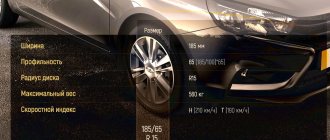Today, there are various wheels for Lada Vesta on the market. The main differences between them are the materials from which they are made, methods of manufacture and fastening, and sizes. To choose the right components for your car, you should know their standard sizes, presented in the table below.
| Tire sizes with speed and load capacity indices | Disk dimensions and parameters | Air pressure in tires on front/rear wheels, MPa (kgf/cm3) | |||
| Rim Width (inches) | Rim offset ET, mm | Partial load | Full load | ||
| Manufacturer's recommended parameters | 175/70 R15 88H | 6J | 50 | 0,21/0,21 | 0,2/0,22 |
| 185/60 R16 91Н | (2,1/2,1) | (2,1/2,1) | |||
| Allowed parameters | 185/65 R15 88T, H | 5J, 5 1/2J, 6J | 50 | 0,21/0,21 | 0,21/0,21 |
| 195/55 R16 87, 91T, H | 5 1/2J, 6J | (2,1/2,1) | (2,1/2,1) | ||
T – permissible speed index within 190 km/h;
N – permissible speed index within 210 km/h;
88 – load capacity index from 88 to 560 kg, 91 – from 91 to 615 kg;
ET – rim offset, indicating the distance from the mating surface of the disk to the middle of its rim;
partial load – the presence of three adults in the cabin, without cargo in the trunk;
full load - the presence of more than three adults in the cabin, or the presence of three adults in the cabin and luggage weighing 50 kg or more (depending on the capacity of the luggage compartment).
The wheel is secured to the car hub using four bolts through the holes on the disk. It has four holes centered on a diameter of 100 mm.
Stamped discs
The simplest and cheapest option is stamped steel wheels for the Lada Vesta. They are made by stamping with a mold. External differences in parts depend on the characteristics of the stamp; in accordance with its shape, the product takes on its final appearance. The main advantage of stamping is strength and resistance to external influences: abrasions, impacts, scratches.
R15 steel wheels are provided by the manufacturer when purchasing a car as standard. Recommended tire sizes are 175/70 R15. You can purchase stampings in many service centers and stores by pre-ordering them on the store’s website, where photographs and prices are presented. The retail price in Moscow starts at 1,300 rubles per piece and can reach 2,500 rubles.
When purchasing disks, you should first check whether fasteners are included in the purchase price. Sometimes fasteners need to be purchased separately.
Alloy wheels
Popular alloy wheels on the Lada Vesta are distinguished by a wide selection of designs and diameters. They are made from a special alloy. In addition to the base metal aluminum, the alloy contains magnesium, strontium and titanium additives. The casting process occurs under high pressure, which promotes rapid hardening of the workpiece. Using computer modeling and milling, the part receives its final shape.
Alloy wheels
The multi-level manufacturing process of alloy wheels explains their high cost. They are lighter in weight, but have less resistance to mechanical damage.
Lada Vesta casting is presented by the manufacturer in two versions:
- r15 rollers are recommended for tires with dimensions 175/70 R15 and 205/60 R15;
- R16 wheels are suitable for tires with dimensions 185/60 R
Alloy wheels 15 radius on the Lada Vesta are provided when purchasing a car in the “luxury” configuration. For an additional fee, alloy wheels 16 radius can be installed as additional equipment on the Lada Vesta.
What is the tire pressure
One of the conditions for successful operation of tires of any type and diameter is normal tire pressure recommended by the manufacturer. Moreover, it may differ slightly - depending on the version of the car and other factors. Recommended pressure at part load:
- with a tire size of 195/55 and a diameter of 16 inches: for the front wheels - 2.1 bar; for the rear wheels – 2.1 bar;
- for tires with dimensions 185/65 and a diameter of 15 inches: for front wheels - 2.1 bar; for the rear wheels - 2.1 bar.
At maximum load for similar tires, the pressure on the front wheels should be 2.0 bar, on the rear wheels - 2.2 bar. You can control this value yourself using a pressure gauge. You can buy it at any auto store. The price will be 200-300 rubles.
What does the size of tires and wheels affect?
Increasing the size of tires and wheels will affect the operation of the Lada Vesta as follows:
- Increasing the disc diameter has a positive effect on the quality of steering and road holding, but reduces the level of comfort on uneven roads.
- Increasing the width of the rim will also improve steering and road holding, but will increase fuel consumption.
- Increasing the tire width will also have a better effect on handling, including on uneven roads and will improve traction (in dry weather). At the same time, gasoline consumption and tire wear will increase, and resistance to aquaplaning will suffer. The noise level will increase.
How to choose wheels for a VAZ Vesta ? To clarify all the choices, you need to understand how a car wheel works, study the existing types of disks, their pros and cons.
Information about engines and oil consumption - in the simplest words
Vesta was supposed to be equipped with three engines. All Vestas are equipped with the Russian 21129 or the new 21279 (2016). The HR16 internal combustion engine from the Renault-Nissan concern with a maximum power of 114 horsepower did not appear. All three engines comply with Euro-5 class, are adapted for winter operation, and can work with several types of transmissions.
21129 - 106 hp engine. With. and a volume of 1.6 liters (1596 cubic centimeters), has 4 pistons arranged in a row. The maximum power is 5800 rpm, which is 78 kW. Maximum torque reaches 4200 rpm. min. This means that the maximum engine power develops at 4000 rpm, then fades out.
21279 - volume 1.8 with 122 horses, in-line, four-piston. This motor is capable of squeezing up to 5900 (90 kW) power revolutions and 3700 torque (170 N m).
Both engines are petrol with electronically controlled fuel injection. Gasoline with a 95 octane rating is recommended for them; Vesta can run at 92. The oil volume in the engines is 4.40 liters. Oil consumption, of course, depends on engine power. The manual Lada Vesta 1.8 “eats” more than the 1.6 liter engine, up to 1 liter per 1000 km. The owners noticed other numbers.
Weight matters
A car disk is a simple flywheel mounted on a hub. To set it in motion, you need to expend a certain amount of energy, the source of which is fuel. And the greater the mass of the wheel, the more fuel will be required to spin it. But it is much more difficult to stop the wheel when its rotation speed is very high. At that moment, a very large load is placed on the braking system. Therefore, not only the comfort and controllability of the car, but also the safety of passengers in the cabin depends on the quality of the disc and the materials used to make it.
Let's summarize all of the above
- If you do not drive at very high speeds, are limited in money and the roads in your city are not of very high quality, feel free to purchase steel wheels for the VAZ Vesta (but together with decorative caps).
- If the “appearance” of a car is of paramount importance to you and high-speed driving is not alien to you, then it is best to purchase alloy wheels. But you must be prepared for the fact that they may burst - then you will need to buy new ones, because alloy wheels cannot be repaired.
- If you are a fan of sporty driving and high speeds, then only forged wheels on the VAZ Vesta will be the optimal solution for you. Their unique properties will allow them to be used for a very long time even under intense loads, because it is almost impossible to disable them. But the very high price of such wheels is the only drawback that prevents everyone from buying them.
Our conclusions are advisory in nature - each car enthusiast decides for himself what suits him best. The online store for rims Kolesa Darom can make your task easier with an online selection of rims by car brand directly on its website. Thanks to this service, you can quickly and easily purchase wheels that are optimal in price/quality/appearance for your car. This will allow it to become more functional, reliable and attractive!
Lada Vesta is a new version of the class B subcompact car, production of which began 3 years ago. Domestic, French and Japanese specialists took part in its development. Car enthusiasts are offered 4 modifications: the Vesta Cross sedan, the Vesta SV station wagon, the Vesta SV Cross SUV and the Vesta SNZh dual-fuel vehicle. They can be purchased in 3 trim levels: Lada Vesta Classic, Comfort, Luxe. The color palette of the body is varied, which allows you to choose a car to suit every taste.
Sanctions
You can pay not only by refusing free repairs. If tires not approved by the factory are noticed by a traffic police inspector on the road, he has the right to draw up a report on the vehicle’s non-compliance with the requirements of the Technical Regulations, clause 5.1 of which states: “Vehicles must be equipped with tires in accordance with the vehicle manufacturers’ operational documentation.” And this is already a reason to terminate registration if the problem is not eliminated.
Wheel markings are usually applied to the inner surface. If you put the Vesta Cross on the same 17-inch wheels, but with different parameters of offset, width and diameter of the central hole, the inspector, of course, will not be able to assess compliance right on the road. But the other diameter is already obvious, and its marking on the tire will tell you.
↑ All colors of Lada Vesta
The names of the body colors have a poetic connotation, which fuels buyers’ interest in the model.
Carnelian is a transparent stone from burgundy to pink. The car's carnelian paint job is a metallic red-pink color.
Angkor means Vesta's chocolate shade.
Metallic blue or blues. The rich color, close to cornflower blue, resembles a sea wave when reflected from the sun.
The intriguing name of the phantom car color matches its meaning. In dim lighting, the car has a dark gray color; in brighter light, it can change to dark brown and orange. This effect is achieved through the “chameleon” coating.
The krypton-colored body is a noble dark green metallic color, without the frivolous light green, flashy bright green shade.
A black car, the shade of which is called black pearl, is nobility and restraint.
Color spectrum
Initially, VAZ is targeting 9 shades, which the model will be painted in. It seems that this is very little, especially considering the mass of colors that cars sport, including models of the domestic concern. But this is a common practice of automobile companies, which always present a limited palette when releasing a new model. However, very soon it expands. This trend will be typical for Vesta.
So far, we can state the presence of 9 shades of Vesta, of which only 3 will be common with models of the Renault Nissan alliance, while the remaining 6 are considered original. Naturally, the starting palette will include the usual and popular colors - silver, black and white.
According to the preliminary version, these will be the following colors: black, white, blue, green, magma, red, pink, lilac.
And this is what these colors are officially called (marketing names):
- glacial (white)
- heartaholic (dark red)
- lime (bright green)
- phantom
- blues (dark blue)
- angkor (light brown)
- black pearl (black)
- krypton (dark green)
- platinum (silver)
- pluto (gray)
↑ White Lada Vesta advantages and disadvantages
Lada Vesta white is the most popular model in Russia and abroad. The glacial color in combination with black contours and body parts, tinted windows, and bright red rear lights gives the car an elegant and sophisticated style.
White color is one of the cheapest in the car color scheme. Other advantages create a preference for this shade:
The peculiarity of a snow-white car on the road is its neutrality. It does not irritate the eyes and does not distract attention.
On a white body, traces of corrosion are more noticeable, which can be attributed to both disadvantages and advantages: it is cheaper and faster to deal with damage to the paintwork at the initial stage.
Lada Vesta is considered the most beautiful in the AvtoVAZ model range; the glacial version of the car has deserved increased attention.
While maintaining recognizable details, such as x-stamping and the shape of the headlights, the model has a strong individual design. Positive reviews were earned by the smoothness of closing and opening doors, stability and maneuverability on any road, spacious interior, trunk and glove compartment.
Main technical characteristics of Lada Vesta:
- front-wheel drive;
- engine capacity 1.6 l or 1.8 l;
- 5-speed manual or robotic transmission;
- average maximum speed 180 km/h;
- maximum technical load 1.7 t;
- tank volume 55 l;
- acceleration time from 0 to 100 km 11-14 seconds;
- gasoline consumption is 6-8 liters per 100 km.
According to reviews from car owners, the disadvantages of the Lada Vesta are associated with such shortcomings as poor-quality gluing of plastic on the doors, rattling of the front mirror, inconvenient design of the cover in the engine compartment, lack of floor mats and fender liner protection. Complaints include the operation of the on-board computer, the multimedia system, the poorly thought-out design of the rear mudguards, the lack of smoothness in the robot's switching, and increased engine oil consumption.
Thickness of paint coating (LPC)
So far, there is no exact information, but since AvtoVAZ is striving for world standards, we can say that the coating thickness will be from 75 to 160 microns. It is with this thickness of paintwork that about 95% of modern cars are produced.
You can determine the approximate thickness of the paintwork using the data available for other VAZ models. So, for Granta this figure is 98 microns, for Kalina it varies from 60 to 90 microns, while for Priora the spread is from 67 to 100 microns. The thickness of the paintwork for LADA Vesta will be approximately in this range.
The Lada Vesta car is one of the most popular among the AvtoVAZ model range. This is due to its modern design, numerous safety systems, and auxiliary devices for comfortable driving. The colors of the Lada Vesta also correspond to the high level of equipment of the model. Some shades appeared for the first time with the release of this particular car. And this is the merit of the new management of the Tolyatti concern.
The Lada Vesta body is painted using modern technologies. First, a layer of high-quality primer is applied to the galvanized metal using cataphoresis. This metal treatment process prevents corrosion from affecting it.
↑ Painting features
The application technology and increased thickness of the paint coating by 25% allow the manufacturer to guarantee 6 years of corrosion-free driving.
The partially galvanized metal frame undergoes sandblasting and degreasing at the first stage.
Sequence of body painting operations:
- in a closed chamber, a layer of primer is applied by automatic spraying;
- drying in a drying chamber;
- application of enamel coating;
- drying;
- surface varnishing;
- control examination;
- manual correction of defects.
After this, the finished body enters the assembly line.
↑ Body care rules to maintain fresh color
To preserve the original snow-white color for a long time, several rules must be followed: avoid prolonged exposure to sunlight, exposure to alkali and petroleum products, remove dirt, promptly identify pockets of corrosion and treat them.
Important! When washing, it is important not to use hot water, foam rubber or cloth; you must use a hose. You cannot wash your car in the cold, in the sun, or leave it to dry without wiping it dry.
Scratches and cracks are treated with anti-rust chemicals, then primed and painted over.
To restore the paintwork, polish is applied to the surface of the body once a month. The desired temperature is about 20 degrees.











